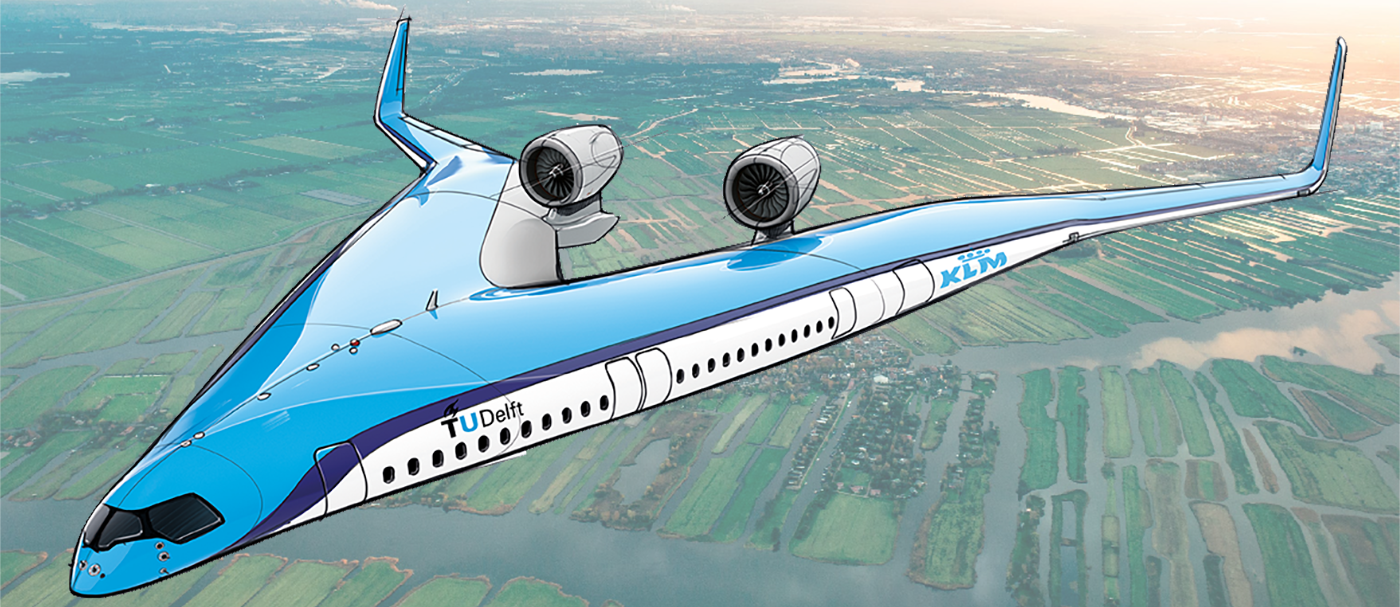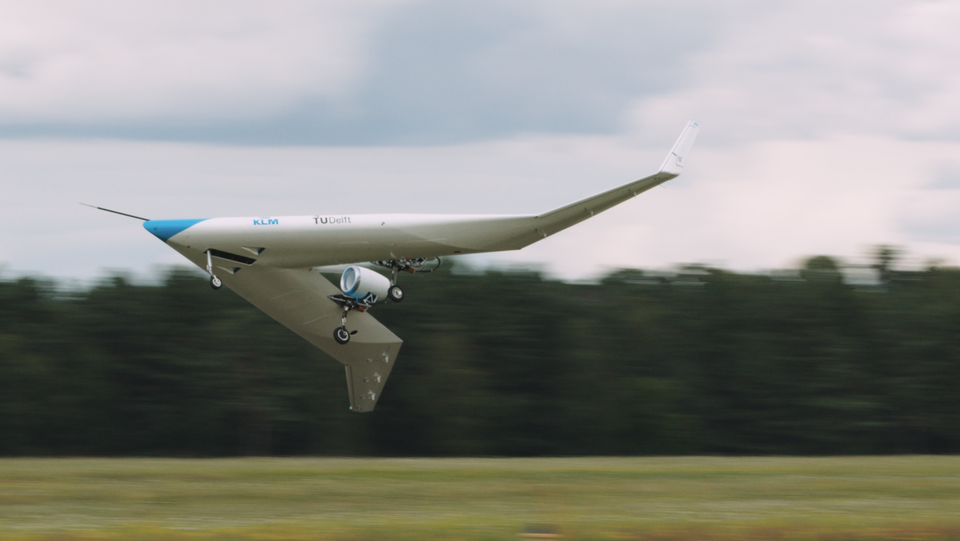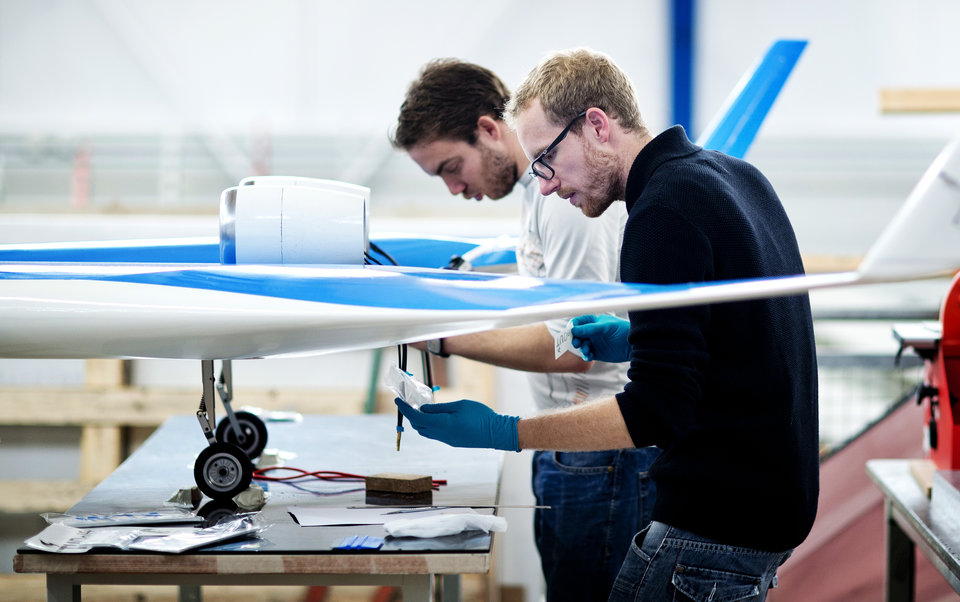Frequently Asked Questions
Please find below the most frequently asked technical questions about the Flying-V per topic.
-
I saw you can retract the landing gear, but in the flight you kept it out the whole time (as far as I can see). Why?
It is standard procedure to leave the gear extended on the first flights in order to reduce the risk of malfunctions. It is not critical to the first flight data that the gear is retracted so to lessen the chance of something going wrong they were left extended. In future flights they will be retracted.How did the landing go?
The combination of Dutch roll and high sensitivity made landing a challenge, something that is already very difficult with model aircraft of this size and speed. The pilot made a first landing attempt but aborted due to being too far down the runway and one of the wobbles took place at low level. Battery levels after this were low, only allowing for one more landing attempt so there was no option to go around again. The aircraft did land but it was a hard landing, due to a nose down movement just before touchdown. This broke the nose landing gear as it took the main impact, something it is not designed for. This brought testing to and end for this campaign but the nose wheel will be repaired for future tests.Why can’t we see the landing in the video?
We have been very open about the landing. Project leader Roelof Vos included it in the actual media presentation and has repeated it in interviews ever since. The choice whether or not to include it in the actual video was a dilemma for us. We want to be open about this, but also know how (social) media work. In the end, we decided to leave it out of the video for the general public and media because we expected (social) media would focus only on the landing, cutting out those images and repeating them over and over again. And in all fairness, the rough landing did not make the flight unsuccessful. In experimental scaled aircraft a rough landing and landing gear breaking happens 2 out of every 3 test flights. Our aim was to show this configuration can fly and to gather data to further design and develop the aircraft. We have shared footage of the landing among our partners. -
The engine is located behind the passenger cabin, reducing the cabin noise. Furthermore, community noise is reduced due to two factors: the fan noise is partially shielded by the wing and the exhaust noise no longer reflects from the lower surface of the wing.
-
How is the fuselage going to meet the drag and get identified by Radar in harsh environments?
This type of flying wing might have a smaller radar reflection in some directions. If it is deemed an issue radar reflectors can be attached to the aircraft which will increase its radar visibility for example. Luckily it is easier to make an aircraft more visible than it is to make it stealthy.What will the flight dynamics be like in cruise flight, when at similar speeds with current aircraft, the aircraft would be in transonic flow?
CFD analysis has been done at transonic cruise conditions where it has been shown that the aircraft does not suffer from strong or unsteady shockwaves. Moreover the control surfaces become more effective at these speeds so control power should not be limiting, also taking into account transonic effects such as the movement of the aerodynamic centre.If the aircraft is so much lighter, is it also affected by wind more?
The Flying V will be slightly lighter than a conventional aircraft of similar size (A350-1000) but it is still heavy in terms of aircraft size. This means that it will not be significantly more susceptible to wind gusts. During design the controllability and responses to cross winds are also taken into account and made sure that the aircraft can safely handle the same conditions that current aircraft can. Verification of these responses still needs to be done, since it is challenging and time consuming to do with CFD. The scaled flight testing model is a good way to investigate this as it naturally gives you the dynamic responses so in future flights the aircraft will be flown in cross wind and gust conditions to validate these topics.How well does the design handle stalls and flatspins?
The inboard wing is very stall resistant, the outboard wing not as much. However, to pitch to high AoA, the elevons are deflected trailing-edge up, off-loading the upper-surface pressure distribution which reduces the lift needed from the outer wing and suppresses stall that way.Flatspins?
Generally transport aircraft are sized such that they do not enter a flatspin while stalling and the Flying-V will be the same. The stall behaviour must be predictable and gentle, without significantly dropping one wing. Additionally, the vertical stabilisers and rudders are sufficiently sized to recover from any yawing motion during stall to not enter the flatspin. This is also the case for the Flying-V and will be verified with flight testing on the scaled model.Most modern aircraft use slats to increase the wing area and lift and enable them to land at a slower speed. How will the Flying-V design do this?
The airplane has no slats or flaps. The design philosophy was to design the airplane without any high-lift movables until it is shown that they are required. The large wing area allows enough lift to be generated at acceptable angles of attack.The high lift-to-drag ratio of the aircraft requires large speed brakes to slow down the aircraft during descent. Therefore split speed brakes are incorporated at the rear part of the undercarriage fairing. These are similar to the ones commonly used at the rear part of fuselages such as on the Fokker 100, the Bae 146, or the Blackburn Buccaneer. Due to their location, the application of speed brakes is not coupled to the lift on the wing, which is improves the flying characteristics of the aircraft.
How will you address issues such as:
- Enormous stresses at the root of the wings
The root of the wing is a highly stressed area and as such additional structural stiffness and strength is needed here. Preliminary structural analysis has confirmed this and also shown that acceptable structural thickness can be used to hold these stresses while not significantly impacting the mass. More detailed research on the structural layout and design is currently being undertaken and the wing root is a focus area. Luckily the large height of the structure, compared to conventional aircraft wings, gives good area moment of inertia which helps to reduce the required thicknesses.
- Disturbed stable air flow around the airfoil caused by the engine location
The engine is positioned based on on-design conditions to mitigate adverse aerodynamic interference. Work is being done to fix vortices on the scale model such as not to interfere with the engine. Furthermore, there is a strong Reynolds number effect on vortex formation. LES calculations have shown that vortices might not appear at the engine location. No simulations have yet been performed yet with engines on and high angle-of-attack conditions.
- The issue of the right weight balance with passengers/loads
As with all conventional aircraft the Flying-V will have a detailed balance envelope with which the aircraft needs to be loaded to maintain a safe centre of gravity location. Balance can be achieved by loading the cargo either more forward or more aft of the cargo bay. There are also trim fuel tanks that can be used for balance. The exact loading envelope has not yet been determined and will be in future research when the design is a bit more evolved. Currently a suitable range of CG travel has been accounted for in handling and stability assessments.
-
What are the manoeuvring loads like at the centre body?
Basic maximum loading conditions have been analysed in the preliminary structural analysis with positive results. Currently a more detailed and evolved structural design is underway. Part if this design process will be the identification and analysis of critical load cases during manoeuvres, gusts, landing and crash impacts for example. -
Do airports need significant changes to handle the aircraft? Or will they be able to fit within current boundaries and restrictions?
Although the plane is not as long as the A350-1000, it does have the same wingspan, 65 m. This allows the Flying-V to use same sized airport gates as the A350-1000, as well as needing similar runway length. Furthermore the same airport infrastructure such as passenger loading bridges and ground equipment can be used. The Flying-V will also use standard cargo containers so no changes are required there. It will also fit in the same hangars as the A350-1000 because the maximum height is similar while having the same wing span and shorter length. -
How will you get this aircraft design certified against FAR / CS-25?
Certification for this aircraft will have to follow the same FAR/CS-25 requirements as conventional aircraft. During this conceptual design phase as many certification requirements are being taken into account as possible without the need to change these requirements. Any changes to regulations will very negatively impact the viability of the Flying-V so they are avoided as much as possible. A detailed investigation into outstanding certification issues will be done in future.How will the aircraft behave in bad weather conditions? Such as landing with severe side wind?
Wind is definitely an important factor to take into account when designing an aircraft. The aircrafts response to gust loads has not elaborately been examined. Tests in a wind tunnel have been done to validate the aircraft’s aerodynamic performance, but these only give a static picture. The test flight with the scaled flight models was important, because you only really know how an aircraft design performs if you fly it in dynamic circumstances.The aircraft has a higher wing area (factor 2 compared to A350-1000) and would therefore have a stronger response to gusts. Furthermore, the natural alleviation that occurs though bending of the wing structure is absent, giving a stronger gust response to the cabin. On the other hand, the lift-curve slop is significantly lower than for conventional aircraft (wind tunnel results show CLa = 2.3 [1/rad]). This reduces the gust-load sensitivity. Further research needs to show what the final effect is on people and structure.
What will the evacuation procedures look like?
Passenger evacuation has not yet been modelled at TU Delft. The number of exits corresponds with guidelines: 4 pairs of Type A exits would theoretically be enough for 440 passengers. However, further study is needed to show that this indeed complies with the 90-second rule.What will be the overall safety issues that will need to be addressed in future research?
There is currently a list of over 50 outstanding research questions which need to be answered. Part of these questions are to do with safety so there are too many to list. Rest assured they will all be attended to as safety and flightworthiness are of the utmost priority.How will future passengers cope with increased inertia forces, if located in the wing?
Studies have shown that if passengers are seated within 11 m of the centre line no significantly uncomfortable accelerations are felt. The Flying-V has been designed so that the seats furthest from the centre are still within this 11 m. Furthermore in a conventional aircraft, while sitting in the nose or tail, a passenger is already further from the rotation point (approximately at the wings) than on the Flying-V. Of course this is in the pitch axis, but there is also turbulence and movements about pitch and it is not viewed as unacceptably uncomfortable by everyone. Also, because the Flying-V has more inertia in the roll axis, because some of the payload is sitting further from the centre, it has a lower sensitivity to rolling turbulence so accelerations would be less. In the end a passenger will only feel accelerations, so a constant standard 1g turn should not be felt, wherever you sit.Is it safe putting the engines above the passengers?
The choice for the engine location is compromise between considerations on weight-and-balance, one-engine-inoperative conditions, aerodynamic interference and structural integration with the landing gear. The engine itself is located behind the passenger cabin. Certification regulations have been taken into account when it comes to positioning of fuel tanks in the wing regarding rotor bursting.What will happen if one engine dies in mid-flight? And what if both malfunction?
If one engine fails the aircraft must be able to maintain level flight and take up the yawing moment created. This is part of certification requirements and as such the Flying-V will also be designed to do so. Preliminary sizing has shown that one engine conditions are a limiting factor for the size of the winglets and rudders but that it will be possible. This will also be verified with the scaled flying model in future. An aircraft is designed to glide perfectly well even if all its engines fail. Aircraft are able to fly through the movement of air passing over the wings. As long as this process continues the aircraft will continue to fly. If both engines fail, the aircraft is no longer being pushed forwards, therefore in order to keep the air flowing over the wings, the aircraft must exchange energy through losing altitude to maintain forward airspeed. This does then mean the aircraft needs to land as soon as possible at the nearest airport or suitable location.As for the control surfaces, I saw the rudders, but are the elevators, ailerons and flaps configured into one unit? In terms of landing and stopping the craft, would engine reverse thrust be the only method? How might you employ air brakes?
Elevons are used on the trailing edge of the outboard wing. These function as elevators and ailerons for pitch and roll control.The high lift-to-drag ratio of the aircraft requires large speed brakes to slow down the aircraft during descent. Therefore split speed brakes are incorporated at the rear part of the undercarriage fairing. These are similar to the ones commonly used at the rear part of fuselages such as on the Fokker 100, the Bae 146, or the Blackburn Buccaneer. Due to their location, the application of speed brakes is not coupled to the lift on the wing, which is improves the flying characteristics of the aircraft.
Due to the fact the aircraft has no flaps, wing-mounted spoilers cannot be applied to quickly dump lift and transfer all the weight to the landing gear upon touch down. Therefore, during touch down, the aircraft rotates to an angle of attack of -3 degrees to ensure that the wing no longer provides any net lift. When the nose wheel touches the runway, the aircraft can start braking without the risk of skidding. Wheel brakes are thus the main stopping force. Thrust reverse can also still be used to reduce break wear as in conventional aircraft.
-
What is new about this design that makes it so promising?
It’s a highly energy efficient aircraft design for long distance flights. The design is expected to use 20% less fuel than today’s most energy efficient aircraft (Airbus A350-1000) due to its aerodynamic shape and reduced weight.What is the difference between a Flying-V and a blended wing body?
A blended wing body, is a fixed-wing aircraft having no clear dividing line between the wings and the main body of the craft. The aircraft has distinct wing and body structures, which are smoothly blended together with no clear dividing line. The Flying-V, however, does not have a central main body as these are integrated in the wings.By cutting out the aft centre section of the blended wing body design, you create the V look. But in doing so you have dramatically increased the structural aspect ratio for the wing spars, thus making them heavier. How did the weight / drag trade go that said this was a good idea?
Wingspan is limited by the size of the airport gate for both cases which usually puts limits on the aspect ratio. Enough wing area has to be provided to achieve low enough stall, take-off and landing speeds. Together these form the structural size of the wing, so cutting out the centre section does not necessarily lead to an increase in aspect ratio, just the distribution of wing area. Luckily on the Flying-V the wings are thick which gives good moment of inertia and it is span loaded, both acting to reduce structural stress and mass.What advantage does this configuration offer over the blended wing concept that Boeing has been working on for the last five years or so? Why not a full delta flying wing?
It is easier to make a family of different sized aircraft with the Flying-V because it has a section of the wing which is constant in cross section so frames can be added or removed without making dedicated moulds or tooling. This has traditionally been very difficult in the blended wing body or delta wing. The integration of a pressurised cabin can also be more challenging in a BWB than for the Flying-V. However these issues could be solved, so the Flying-V does not eliminate the BWB concept, they can also exist in parallel and be optimised for the various missions to which they are best suited. It is not a case of one or the other.Why isn’t the Flying-V design part of the sustainable designs Airbus presented in September 2020?
Airbus wants to keep its options open for the time being, It is still early stages for these new concepts so it is still too early to make a definite choice. They have not decided for or against the Flying-V or BWB as more work is still needed to determine which is better and for which missions. -
Where can we find scientific papers about the Flying-V?
The TU Delft Education Repository has all of the master thesis work performed on the Flying-V. Furthermore there are academic publications with the AIAA that can be viewed with subscriptions.Where is the evidence that a flying wing is more efficient than a conventional design? The reflexed foils you will require to get the right pitching moments, not to mention handling transonic speeds and Mach tuck, will never be more efficient than a conventional wing with a horizontal stab. Or is it?
With proper design, reflex airfoils are not necessarily required if the planform parameters and longitudinal lift distribution is chosen correctly. The same goes for the management of Mach tuck, which conventional aircraft can also suffer from if not taken into account. These aspects have been studied in CFD simulations where it has been shown that the Flying-V is still stable and controllable at cruise speeds with the resulting aerodynamic efficiency. Also, not to be forgotten, is that analyses show that the Flying-V is lighter than comparable conventional aircraft, which improves the efficiency separate to these aerodynamic challenges.




